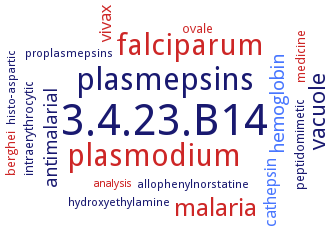3.4.23.B14: plasmepsin IV
This is an abbreviated version!
For detailed information about plasmepsin IV, go to the full flat file.

Word Map on EC 3.4.23.B14 
-
3.4.23.B14
-
plasmepsins
-
plasmodium
-
falciparum
-
malaria
-
vacuole
-
hemoglobin
-
antimalarial
-
cathepsin
-
vivax
-
ovale
-
intraerythrocytic
-
medicine
-
peptidomimetic
-
berghei
-
hydroxyethylamine
-
allophenylnorstatine
-
histo-aspartic
-
proplasmepsins
-
analysis
- 3.4.23.B14
-
plasmepsins
- plasmodium
- falciparum
- malaria
- vacuole
- hemoglobin
-
antimalarial
- cathepsin
- vivax
- ovale
-
intraerythrocytic
- medicine
-
peptidomimetic
- berghei
-
hydroxyethylamine
-
allophenylnorstatine
-
histo-aspartic
-
proplasmepsins
- analysis
Reaction
cleavage of hemoglobin. In the S3 and S2 subsites, the plasmepsin 4 orthologs all prefer hydrophobic amino acid residues, Phe or Ile, but reject charged residues such as Lys or Asp. In S2' and S3' subsites these plasmepsins tolerate both hydrophobic and hydrophilic residues =
Synonyms
A01.059, PfPM4, PgPM4, plasmepsin 4, Plm IV, PM IV, PM-IV, PM4, PMIV, PmPM4, PoPM4, pPM IV, proplasmepsin IV, PSM4, PvPM4
ECTree
Advanced search results
Crystallization
Crystallization on EC 3.4.23.B14 - plasmepsin IV
Please wait a moment until all data is loaded. This message will disappear when all data is loaded.
hanging-drop vapor-diffusion method, crystals of PmPM4 in complex with the small-molecule inhibitor AG1776. The crystals are orthorhombic, with space group P2(1)2(1)2 and unit-cell parameters a = 95.88 A, b = 112.58 A, c = 90.40 A, two molecules per asymmetric unit
-
truncated proplasmepsin IV, sitting drop vapor diffusion method, using 100 mM sodium citrate pH 4.7, 25% (w/v) PEG 3350, 200 mM ammonium acetate
hanging-drop vapor-diffusion method, crystal structure of plasmepsin 4 bound to the allophenylnorstatine-based compound KNI-764 at 3.3 A resolution. The PmPM4inhibitor complex crystallized in the ortho-rhombic space group P2(1)2(1)2, with unit-cell parameters a = 95.9 A, b = 112.6 A, c = 90.4 A, with two molecules in the asymmetric unit
-
pKa calculations for PM IV complexed with the inhibitor KNI-764. Residue Asp214 is protonated, while residue Asp34 is deprotonated. In the colmplex, the hydroxyl group interacts with the OD2 oxygen atom of Asp34 through a hydrogen bond. The hydroxyl group also presents a hydrogen bond interaction with acid aspartic protonated Asp214. The amino groups of Gly78 and Ser79 residues interact with KNI-764 forming hydrogen bonds at 2.02 and 2.20 A. The hydroxyl group of Thr217 forms hydrogen bonds with the inhibitor at 2.06 A
analysis of 3D model of PM4 shows a typical aspartic protease structure with bi-lobed, compact and distinct peptide binding cleft


 results (
results ( results (
results ( top
top





